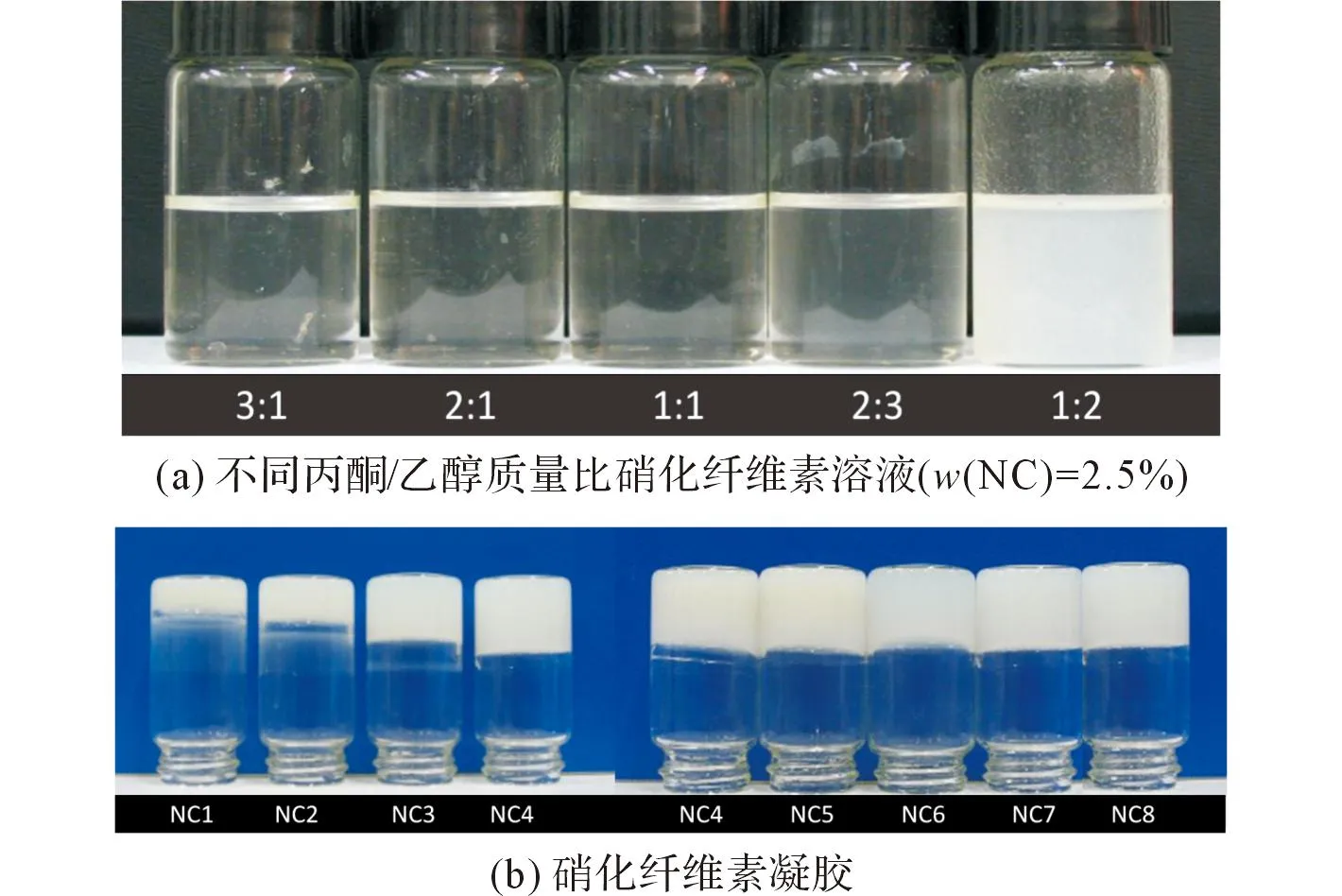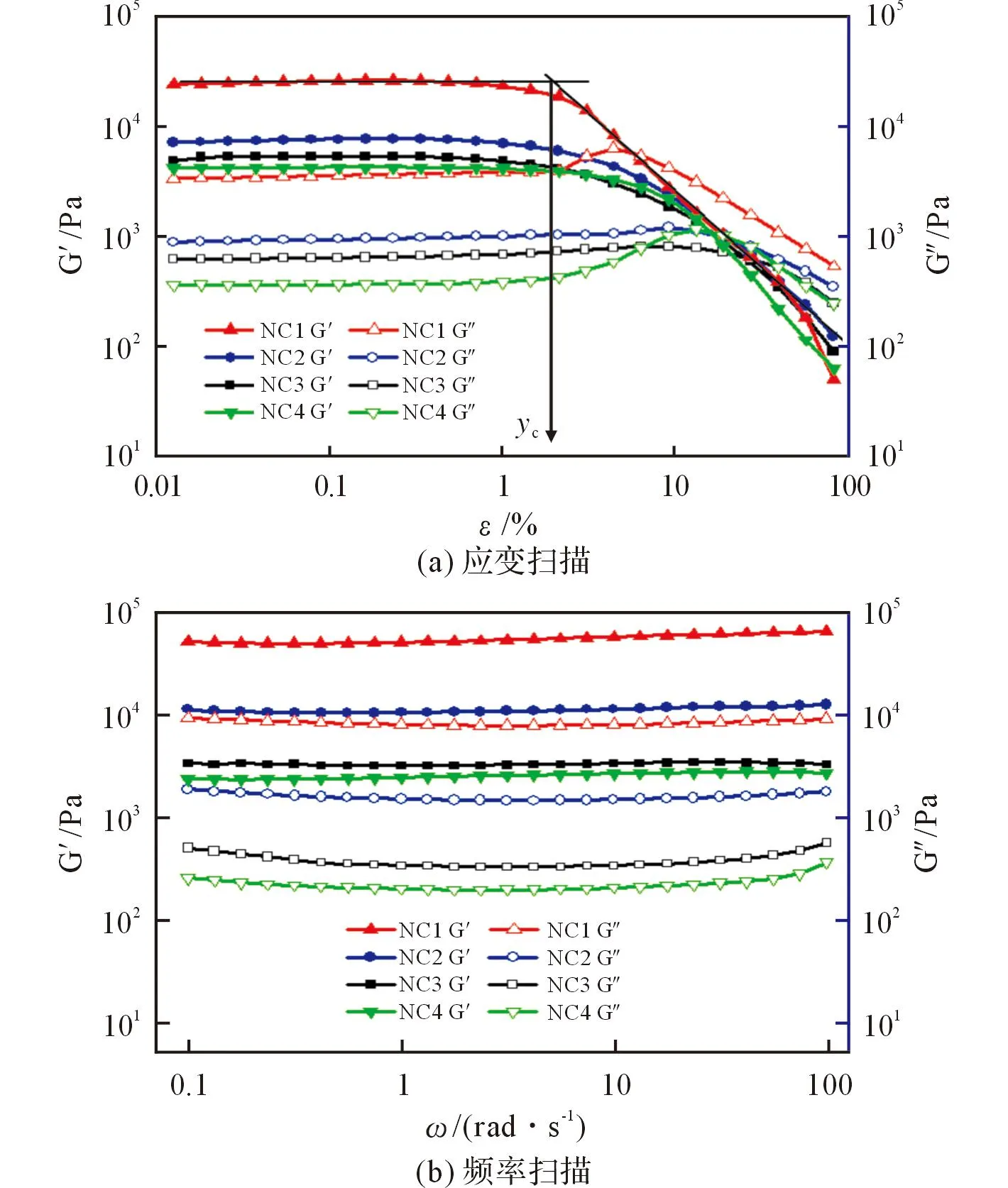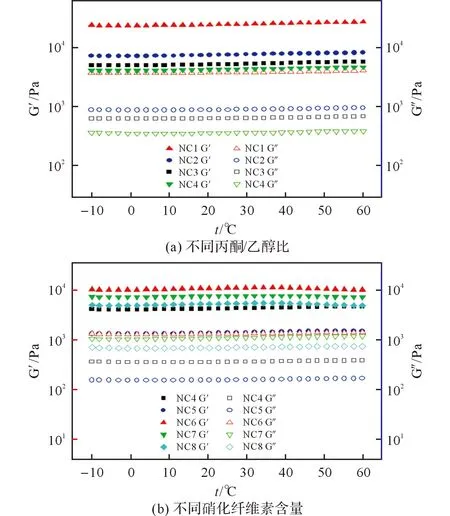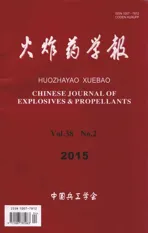三元体系相分离制备硝化纤维素凝胶及其动态流变性的研究
2015-03-05张云华邵自强
张云华,邵自强
(北京理工大学材料学院,北京100081)
三元体系相分离制备硝化纤维素凝胶及其动态流变性的研究
张云华,邵自强
(北京理工大学材料学院,北京100081)
摘要:通过溶剂蒸发引发相分离从硝化纤维素/丙酮/乙醇三元体系中制备出硝化纤维素凝胶,采用线性流变学方法考察凝胶对外界刺激(如应变、频率、温度)的响应程度,研究了凝胶的动态流变性能。结果表明,溶剂/非溶剂(丙酮/乙醇)质量比或硝化纤维素含量影响最终硝化纤维素凝胶的形貌,改变溶剂比例与硝化纤维素含量对硝化纤维素凝胶的动态流变性能的影响不同,增加丙酮含量,制备出的硝化纤维素凝胶体积减小,凝胶中硝化纤维素的含量增加,储能模量G′和损耗模量G″增加,临界应变(γc)随凝胶中硝化纤维素含量的增加而减小;当丙酮/乙醇的质量比为2∶3时,增加硝化纤维素含量,G′和G″值会随着凝胶中硝化纤维素含量的增加先增大后减小。所有硝化纤维素凝胶的储能模量G′和损耗模量G″在整个温度扫描中基本不变,表明硝化纤维素分子链间和硝化纤维素/溶剂间的相互作用不会被升温破坏。
关键词:物理化学;相分离; 溶剂/非溶剂; 硝化纤维素凝胶; 流变性能
引言
硝化纤维素(NC)是一种重要的天然纤维素衍生物[1]。含氮量高于12%(质量分数)的硝化纤维素常作为含能组分应用于火炸药、气体发生器、推进剂等领域[2-3]。研究表明[8],将硝化纤维素制备成凝胶,可扩大其在火炸药、推进剂、分离提纯和生物医药领域的应用。制备凝胶材料的方法主要有交联剂化学交联、纳米结构单元自组装、分子链聚集引发相分离等[9-14]。其中,聚合物体系相分离可以由溶剂蒸发、改变温度或添加非溶剂引发[15]。非溶剂引发相分离过程中,受聚合物/良溶剂/非溶剂三元体系各组分浓度和性能影响,相分离可以最终导致多孔膜或物理凝胶的形成[16-20]。
Peterson等[12]通过溶剂蒸发引发相分离,在硝化纤维素/乙醚/醇三元体系中制备出具有多级孔隙结构的硝化纤维素气凝胶,然而,乙醚/乙醇体系只能溶解部分硝化纤维素,限制了其使用。与乙醚/乙醇体系相比,丙酮能溶解几乎所有硝化纤维素,被认为是硝化纤维素的最佳溶剂[19]。本研究在硝化纤维素/丙酮/乙醇体系中成功制备硝化纤维素凝胶,研究了三元体系中丙酮/乙醇质量比及硝化纤维素含量对硝化纤维素凝胶动态流变性能的影响,为进一步制备纯硝化纤维素气凝胶骨架或硝化纤维素基纳米复合材料奠定基础。
1实验
1.1试剂与仪器
硝化纤维素,取代度2.6,四川硝化棉公司;无水乙醇、丙酮,分析纯,北京化工厂。
奥地利Anton Paar physica MCR 301高级旋转流变仪;日本佳能(Canon)EOS7D单反相机。
1.2硝化纤维素凝胶的制备
向100mL烧杯中加入预先配制好的丙酮/乙醇溶液(质量比分别为3∶1、2∶1、1∶1、2∶3)48.75g,磁力搅拌下加入1.25g硝化纤维素;100mL烧杯中分别加入丙酮/乙醇混合溶液(质量比为2∶3)49.25、48.25、47.75、47.00g,磁力搅拌下分别加入硝化纤维素0.75、1.75、2.25、3.00g。室温下搅拌均匀得到硝化纤维素/丙酮/乙醇溶液三元体系,组成见表1。

表1 硝化纤维素/丙酮/乙醇溶液组成
将8g 硝化纤维素/丙酮/乙醇溶液置于20mL试样瓶中,然后放置在恒温恒湿(25℃,相对湿度40%)环境中自然蒸发,直至形成稳定的硝化纤维素凝胶。
1.3流变性能测试
高级旋转流变仪的动态应变扫描范围0.01%~100 %,频率固定为10 rad/s。频率扫描范围0.1~100 rad/s,应变为0.2%。温度扫描范围-10~60℃,频率10 rad/s,升温速率5℃/min。除温度扫描,其他测试温度为25℃。每个样品测试重复3次,测试结果的相对误差小于10%。
2结果与讨论
2.1溶剂/非溶剂质量比及硝化纤维素含量对凝胶形貌的影响
不同丙酮/乙醇质量比时硝化纤维素溶液及硝化纤维素凝胶的照片见图1。

图1 不同丙酮/乙醇质量比时硝化纤维素溶液及硝化纤维素凝胶的照片Fig.1 Photographes of NC solution and NC gels withdifferent acetone/ethanol ratio
由图1(a)可见,在硝化纤维素的溶解过程中,当乙醇含量过高(丙酮/乙醇质量比1∶2)时,由于溶剂对硝化纤维素溶解能力减弱,出现相分离导致溶液变浑浊。相分离可能是因为乙醇含量较高时,没有足够的丙酮与硝化纤维素分子溶剂化作用,部分硝化纤维素分子链相互缠结导致相分离。澄清的硝化纤维素溶液经过溶剂部分蒸发以后,由于丙酮比乙醇相对挥发速率更大,导致体系中乙醇含量逐渐升高,所有溶液体系均出现相分离并形成凝胶,如图1(b)所示。此外,由图1(b)可见,丙酮含量较高时,制得的硝化纤维素凝胶具有更小的体积及质量,凝胶中硝化纤维素含量较大;溶剂组成相同,硝化纤维素含量不同时,制备的硝化纤维素凝胶体积相近。
2.2溶剂/非溶剂质量比对硝化纤维素凝胶流变性能的影响
为了研究溶剂/非溶剂质量比对硝化纤维素凝胶流变性能的影响,对不同丙酮/乙醇质量比制备的硝化纤维素凝胶进行应变扫描和频率扫描,储能模量(G′)和损耗模量(G″)结果见图2。

图2 不同丙酮/乙醇比时硝化纤维素凝胶的储能模量(G′)和损耗模量(G″)曲线Fig.2 The storage modulus G′ and loss modulus G″ forNC gels with different acetone/ethanol ratios
由图2(a)可见,低应变下,随着应变(ε)的增加,G′和G″基本不变,说明此时凝胶具有较稳定的三维网络结构,处于其线性黏弹性区域。ε>1%时,随着应变的增加,G′开始下降。应变超过某一临界值(γc)时,凝胶结构的破裂或屈服会导致G′迅速下降。这一临界应变值(γc)可根据Swerin等[21]报道的方法计算出来。根据应变扫描中γc值的变化,凝胶可以分为强连接和弱连接两类。强连接凝胶中,聚集体之间的连接作用强于聚集体内的连接,γc值随样品浓度增加而减小,弱连接凝胶中则正好相反。图2(a)中γc值随硝化纤维素含量的增加而减小,说明其表现为强连接凝胶。此外,线性黏弹性区域中G′和G″随硝化纤维素含量的增加而增加。
由图2(b)可见, 所有样品G′总是大于G″,且G′和G″与角频率的关系指数都接近零。整个频率扫描范围内,任一样品G′和G″间不存在交点,说明所有样品都处于具有高弹性的凝胶状态。此外,G′和G″随硝化纤维素凝胶中硝化纤维素含量的增加而增加,这一结果与上面的应变扫描结果一致。以上结果说明,丙酮含量较高时,需要更多时间蒸发溶剂,因而制得的凝胶更均匀密实,导致其具有更高的模量。
2.3硝化纤维素含量对硝化纤维素凝胶流变性能的影响
图3为不同硝化纤维素含量制备的硝化纤维素凝胶应变扫描和频率扫描的储能模量(G′)和损耗模量(G″)曲线。

图3 不同硝化纤维素含量硝化纤维素凝胶的储能模量(G′)和损耗模量(G″)曲线Fig.3 The storage modulus G′ and loss modulus G″ forNC gels prepared under different NC contents
由图3(a)可知,随着硝化纤维素含量的增加,硝化纤维素凝胶G′和G″值增大(样品NC4到NC6);随着硝化纤维素含量的进一步增加(样品NC6到NC8)模量下降。γc值也随硝化纤维素含量的增加呈先减小后增加,表明硝化纤维素凝胶从强凝胶转为弱凝胶。由图3(b)可见,G′和G″值随凝胶中硝化纤维素含量的增加呈先增加后下降,这一结果与应变扫描结果一致。结果表明,初始硝化纤维素含量较低的溶液,聚集体之间的连接作用强于聚集体内部作用,随着硝化纤维素含量的增加,聚集体内部作用不断增强,直至硝化纤维素含量大于某一值时,聚集体内部作用强于聚集体之间的作用。不同硝化纤维素含量的凝胶模量随凝胶中硝化纤维素含量的增加先增大后减小,而不同丙酮/乙醇质量比制备的凝胶的模量随凝胶中硝化纤维素含量的增加而增加,表明改变丙酮/乙醇质量比和改变硝化纤维素含量会对硝化纤维素凝胶流变性能带来不同影响。
2.4温度对硝化纤维素凝胶流变性能的影响
为研究温度对硝化纤维素凝胶流变性能的影响,在频率为10 rad/s、升温速率为5 ℃/min条件下,对硝化纤维素凝胶进行温度扫描,结果见图4。

图4 温度扫描下硝化纤维素凝胶储能模量G′和损耗模量G″曲线Fig.4 The storage modulus G′ and loss modulus G″for NC gels under temperature function
由图4可见,在整个温度扫描中(-10~60℃)硝化纤维素凝胶的G′和G″值基本不变,表明硝化纤维素分子链间和硝化纤维素/溶剂间的相互作用不会被升温破坏。
3结论
(1)通过溶剂蒸发引发相分离从硝化纤维素/丙酮/乙醇三元体系中制备出硝化纤维素凝胶。
(2)增加丙酮的含量,硝化纤维素凝胶储能模量G′值和损耗模量G″值增大,临界应变(γc)随硝化纤维素凝胶中硝化纤维素含量的增加而减小,凝胶表现为强连接凝胶。
(3)当丙酮/乙醇质量比为2∶3时,随着硝化纤维素含量的增加,硝化纤维素凝胶的G′和G″值先增大后减小,硝化纤维素凝胶从强凝胶转为弱凝胶。
(4)硝化纤维素凝胶的G′和G″在整个温度扫描中基本不变,表明硝化纤维素分子链间和硝化纤维素/溶剂间的相互作用不会被升温破坏。
参考文献:
[1]邵自强,王文俊. 硝化纤维素结构与性能[M].北京:国防工业出版社,2011.
[2]Pourmortazavi S M, Hosseini S G, Rahimi-Nasrabadi M, et al. Effect of nitrate content on thermal decomposition of nitrocellulose[J].Journal of Hazardous Materials, 2009, 162(2-3):1141-1144.
[3]Katoh K, Ito S, Kawaguchi S, et al. Effect of heating rate on the thermal behavior of nitrocellulose[J]. Journal of Thermal Analysis and Calorimetry, 2010, 100(1):303-308.
[4]Tappan B C, Brill T B. Thermal decomposition of energetic materials 86. Cryogel synthesis of nanocrystalline CL-20 coated with cured nitrocellulose[J].Propellants, Explosives, Pyrotechnics, 2003, 28(5):223-230.
[5]Li J, Brill T B. Nanostructured energetic composites of CL-20 and binders synthesized by sol gel methods[J]. Propellants, Explosives, Pyrotechnics, 2006, 31(1):61-69.
[6]晋苗苗,罗运军.硝化棉气凝胶的制备及表征[J].火炸药学报,2013,36(1):82-86.
JIN Miao-miao, LUO Yun-jun. Preparation and characterization of nitrocellulose aerogels[J]. Chinese Journal of Explosives and Propellants, 2013, 36(1):82-86.
[7]Li J, Lu Y, Yang D, et al. Lignocellulose aerogel from wood-ionic liquid solution (1-allyl-3-methylimidazolium chloride) under freezing and thawing conditions[J]. Biomacromolecules, 2011, 12(5):1860-1867.
[8]吕少一,邵自强,王飞俊,等. 新型含能胶凝剂的制备及其凝胶流变性能[J]. 火炸药学报,2011,34(1):49-53.
Lü Shao-yi, SHAO Zi-qiang, WANG Fei-jun, et al. Preparation of new energetic gelator and rheological properties of its gel[J].Chinese Journal of Explosives and Propellants, 2011, 34(1):49-53.
[9]Brock S L. All-Inorganic Nanocrystal Arrays[J]. Angewandte Chemie-International Edition, 2009, 48(41):7484-7486.
[10]ElKhatat A M, Al-Muhtaseb S A. Advances in tailoring resorcinol-formaldehyde organic and carbon gels[J]. Advanced Materials, 2011, 23(26):2887-2903.
[11]Heath L, Thielemans W. Cellulose nanowhisker aerogels[J]. Green Chemistry, 2010, 12(8):1448-1453.
[12]Peterson G R, Cychosz K A, Thommes M et al. Solvent-tuned hierarchical porosity in nitrocellulose aerogels[J]. Chem Commun (Camb), 2012, 48(96):11754-11756.
[13]Charani P R, Dehghani-Firouzabadi M, Afra E, et al. Rheological characterization of high concentrated MFC gel from kenaf unbleached pulp[J]. Cellulose, 2013:1-14.
[14]Jullander I, Blom-Sallin B S. Cross linking of nitrocellulose studied with the ultracentrifuge and consistometer[J]. Journal of Polymer Science, 1948, 3(6):804-811.
[15]Khalil S A. Phase separation of cellulose derivatives: effects of polymer viscosity and dielectric constant of nonsolvent[J]. Journal of pharmaceutical sciences, 1973, 62(11):1883-1884.
[16]Vaessen D M, McCormick A V, Francis L F. Effects of phase separation on stress development in polymeric coatings[J]. Polymer, 2002, 43(8):2267-2277.
[17]Appaw C, Gilbert R D, Khan S A, et al. Phase separation and heat-induced gelation characteristics of cellulose acetate in a mixed solvent system[J]. Cellulose, 2010, 17(3):533-538.
[18]Chen P, Yu H, Liu Y, et al. Concentration effects on the isolation and dynamic rheological behavior of cellulose nanofibers via ultrasonic processing[J]. Cellulose, 2013, 20(1):149-157.
[19]Kadla J F, Hsieh C-W C. Effect of processing conditions on gel formation in ternary cellulose acetate systems[J]. Cellulose, 2011, 19(1):69-79.
[20]Kadla J F, Korehei R. Effect of hydrophilic and hydrophobic interactions on the rheological behavior and microstructure of a ternary cellulose acetate system[J]. Biomacromolecules, 2010, 11(4):1074-1081.
[21]Swerin A, Powell R, dberg L. Linear and nonlinear dynamic viscoelasticity of pulp fiber suspensions[J]. Nordic Pulp and Paper Research Journal, 1992, 7(3):126-143.
Preparation of Nitrocellulose Gel Based on Phase Separation in
Ternary System and Study on Its Dynamic Rheological Characteristics
ZHANG Yun-hua, SHAO Zi-qiang
(School of Materials Science and Engineering, Beijing Institute of Technology, Beijing 100081,China)
Abstract:The nitrocellulose (NC) gels were prepared from a ternary system NC/acetone/ethanol by solvent evaporation induced phase separation. The response degrees of the gel to external stimuli (such as strain, frequency, temperature) were investigated by linear rheological methods. Dynamic rheological characteristics of NC gels were studied. Results show that the final morphologies of NC gels are influenced by mass ratios of the initial solvent/non-solvent (acetone/ethanol) and NC contents. The effect of changing initial acetone/ethanol ratios on the dynamic rheological characteristics of the NC gels is different from the effect of changing NC contents. With increasing the acetone content, the volume of the NC gel prepared decreases, the NC content in the gel increases, the storage modulus (G′) and loss modulus (G″) of NC gels increase as well as the critical strain value (γc) decreases with increasing the NC content in the gels, whereas the value ofG′ andG″ first increase and then decrease with increasing the NC content in the gels when the mass ratio of acetone/ethanol is 2∶3. The values ofG′ andG″ of all NC gels over the entire temperature scanning are basically unchanged, indicating that the interactions among NC chains and between NC/solvent can not be disrupted upon heating to higher temperatures.
Keywords:physical chemistry; phase separation; solvent/nonsolvent; nitrocellulose gels; rheological behavior
作者简介:张云华(1987-),男,博士研究生,研究方向为纤维素及改性硝化纤维素。
收稿日期:2014-10-14;修回日期:2015-01-14
中图分类号:TJ55; TQ352
文献标志码:A
文章编号:1007-7812(2015)02-0070-05
DOI:10.14077/j.issn.1007-7812.2015.02.016
